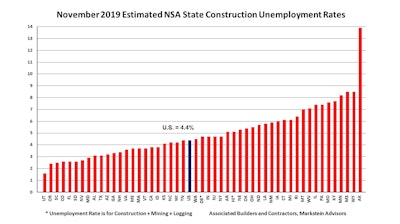
In November, estimated not seasonally adjusted (NSA) construction unemployment rates increased nationally and in 38 states, fell in 11 states and were unchanged in one state (Washington) on a year-over-year basis, according to an Associated Builders and Contractors (ABC) analysis of U.S. Bureau of Labor Statistics (BLS) data.
As of November 2019, the construction industry employed 145,000 more workers nationally compared to November 2018, even as the national NSA construction unemployment rate climbed from 3.9% to 4.4% over the same period, according to BLS numbers. This continues the trend of declining year-over-year growth in construction employment. November’s rise in year-over-year employment is the smallest increase since the January 2013 increase of 116,000.
 Historically, construction unemployment rates increase from October.Associated Builders and Contractors
Historically, construction unemployment rates increase from October.Associated Builders and Contractors
Because these industry-specific rates are not seasonally adjusted, national and state-level unemployment rates are best evaluated on a year-over-year basis. The monthly movement of rates still provides some information, although extra care must be used when drawing conclusions from these variations.
The national NSA construction unemployment rate increased 0.4% from October to November. The historical pattern generally has been an increase in rates from October. Prior to this year, there were 15 increases, two decreases and two unchanged rates since the data series began in 2000. Among the states, 38 had higher estimated construction unemployment rates than in October, while nine were lower and three were unchanged (California, Massachusetts and South Dakota).
The top five states
The states with the lowest estimated NSA construction unemployment rates in order from lowest to highest were:
- Utah, 1.6%2
- Oregon, 2.4%3
- South Carolina, 2.5%
- Colorado, Florida and South Dakota (tie), 2.6%
Three of these states — Florida, South Carolina and Utah — were in the top five in October. For the third consecutive month, Utah had the lowest construction unemployment rate among the states, which was also the state’s second lowest November rate on record, behind a rate of 1.4% in 2015. It was also the state with the largest year-over-year decrease in its rate, down 1.1%.
Oregon had the second lowest rate in November, up from 12th lowest in October (tied with Nevada). It was also Oregon’s lowest November rate on record. The state had the second largest monthly decrease, down 0.6%, behind Georgia.
South Carolina had the third lowest rate in November, up from fourth lowest rate in October. This was the state’s lowest November rate on record.
Colorado, Florida and South Dakota tied for the fourth lowest rate in November. For Colorado, this was up from sixth lowest in October and was the state’s lowest November rate on record, matching its 2016 rate.
For Florida, this was compared to fifth lowest rate in October and the state’s second lowest November rate on record, behind the 2.5% rate in 2005.
For South Dakota, this was up from seventh lowest in October (tied with Maine and Maryland) and the state’s second lowest November rate on record, behind last year’s 2% rate.
 Temperatures and national disasters both played roles in decreased construction employment in November.Associated Builders and Contractors
Temperatures and national disasters both played roles in decreased construction employment in November.Associated Builders and Contractors
North Dakota, which had the third lowest rate in October, dropped to 34th lowest in November with a 5.7% rate.
The bottom five states
The states with the highest estimated NSA construction unemployment rates in order from lowest to highest were:
- Kentucky, 7.7%
- Minnesota, 8.2%
- Mississippi and Wyoming (tie), 8.5%
- Alaska, 13.9%
Three of these states — Alaska, Kentucky and Mississippi — were also in the bottom five in October. For the third month in a row, Alaska had the highest estimated construction unemployment rate. Nevertheless, this was the state’s second lowest November rate on record since reaching 12.8% last year. Alaska had the largest monthly increase among the states, up 4%.
Mississippi and Wyoming tied for the second highest rate in November. For Mississippi, this was the same rank as in October. It is also the eighth straight month that the state has had either the highest or second highest estimated construction unemployment rate.
For Wyoming, this compares to sixth highest in October. Wyoming had the largest year-over-year increase in its rate, up 3.7%, while Mississippi had the third largest increase, up 2.8%.
Minnesota had the fourth highest rate in November compared to 21st highest in October (tied with Rhode Island). The state had the second highest year-over-year and monthly increase in its rate, up 3.5% and 3.9%, respectively.
Kentucky had the fifth highest rate in November compared to third highest in October.
Pennsylvania, which had the fourth highest rate in October, tied with Illinois for the seventh highest in November with a rate of 7.4%.
West Virginia, which had the fifth highest rate in October, ranked ninth highest in November at 7.1%. This was the state’s third lowest November rate on record behind 5.1% last year and 6.2% in 2007.


















